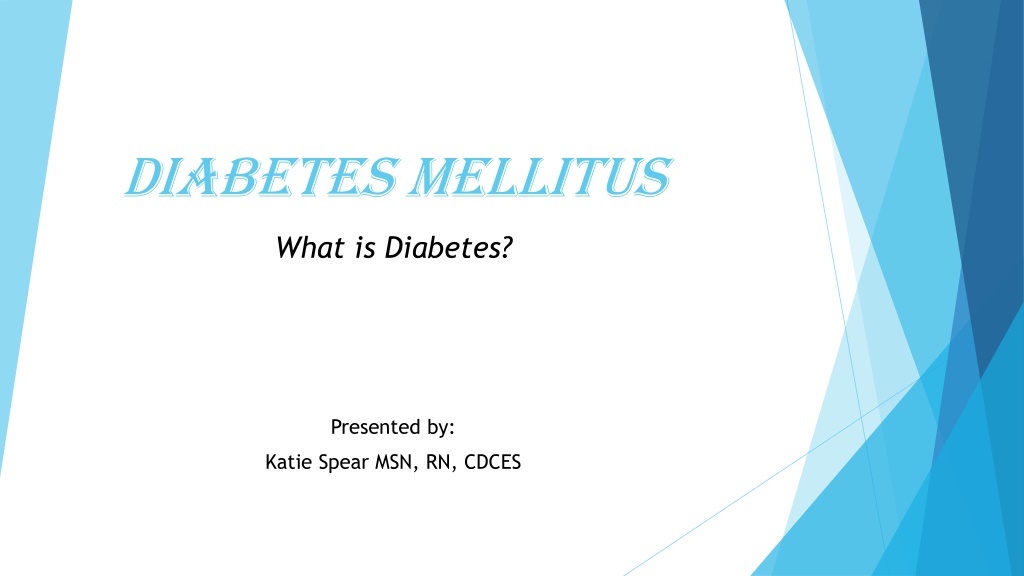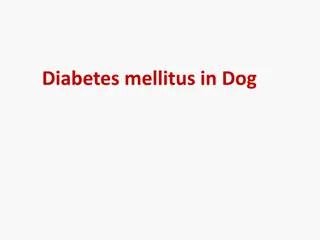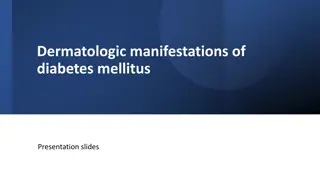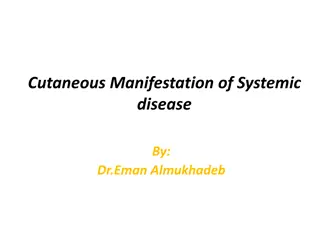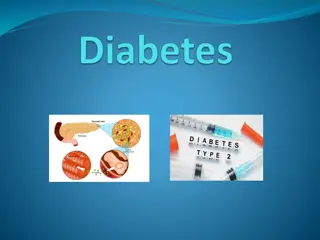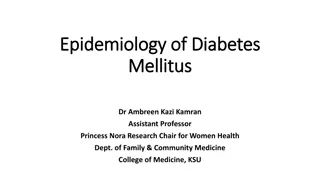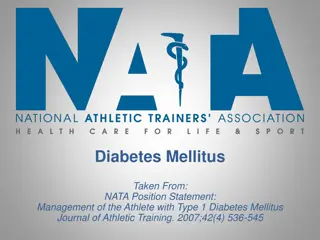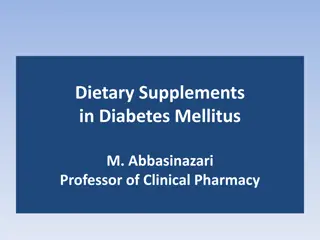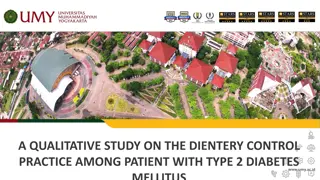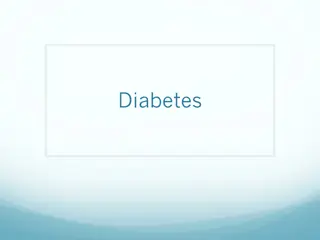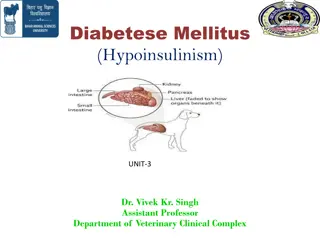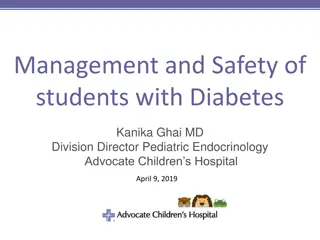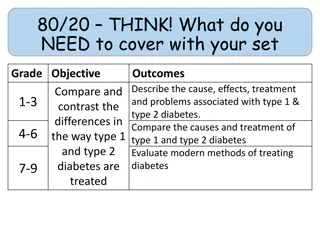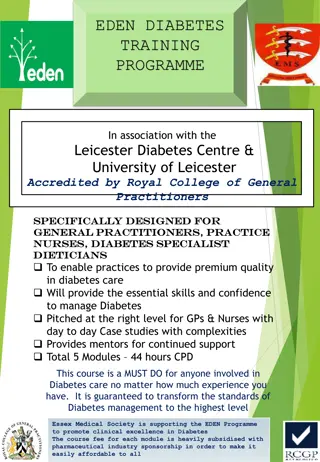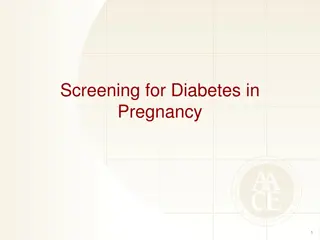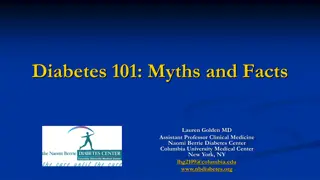Understanding Diabetes Mellitus: Causes, Effects, and Management
Diabetes Mellitus is a condition characterized by high blood sugar levels due to insufficient insulin production or utilization. It affects various organs and requires careful management through lifestyle changes, medication, or insulin therapy. While the exact causes are still being researched, factors like genetics, obesity, and gestational diabetes play a role. Effective management involves maintaining blood glucose levels, adopting a healthy lifestyle, and seeking medical support when necessary.
Uploaded on Sep 28, 2024 | 0 Views
Download Presentation

Please find below an Image/Link to download the presentation.
The content on the website is provided AS IS for your information and personal use only. It may not be sold, licensed, or shared on other websites without obtaining consent from the author. Download presentation by click this link. If you encounter any issues during the download, it is possible that the publisher has removed the file from their server.
E N D
Presentation Transcript
Diabetes Mellitus What is Diabetes? Presented by: Katie Spear MSN, RN, CDCES
3 Takeaway Points 1. How the pancreas is the problem in diabetes. 2. How high blood glucoses or blood sugar effects your body. 3. The main two types of diabetes.
What is diabetes mellitus? Diabetes is basically high sugar in the blood that is not able to be used effectively. Your body needs to have sugar to help every part of your body work. You eat food, which turns into sugar, and is then used for fuel and energy. High blood sugars result from a pancreas that quits working. The pancreas secretes insulin to help sugar to be used by the body for energy. Insulin is the key that opens the door for sugar to get into the cells to be sued. When blood sugar builds up, it becomes very thick and sticky, like Karo Syrup. It is very difficult for this thick blood to move through your blood vessels, especially the small ones, like the ones that are in your eyes, kidneys and heart. So, high blood sugar effects every organ, including your brain, heart, kidneys, eyes, and your feet. This is why it is so important to keep it under control.
Insulin: Insulin is a hormone that is needed to assist blood glucose into the cells of your body for fuel and energy. It is steadily produced in a healthy body. It is like a key that opens the cells to let the glucose in to be used.
What Is Diabetes? Type 1 Diabetes Type 2 Diabetes The body quits making insulin. The body does make insulin, but it may not make enough to be used adequately. Insulin is necessary to help sugar get into the body s cells so it can be used for energy or stored for later use. or, the cells in the body may become insulin-resistant (not able to utilize the insulin). (Like using a key that does not fit). Insulin needs to be replaced, The body cannot live without it. Lifestyle changes, such as walking, or some type of activity, weight loss, and healthy eating may help to get blood glucose under control. If not, medication is needed. Insulin injections are given by a shot, or by a continuous pump.
Causes of Diabetes Type 1 Diabetes Type 2 Diabetes Risk Factors: Scientists aren t sure what causes type 1 diabetes. It is not contagious and it is not caused by eating sugar. Research is under way to find the exact causes of type 1 diabetes and how it might be prevented. Being overweight Family history of diabetes Having gestational diabetes during pregnancy. Autoimmune- the body attacks itself, specifically the beta cells of the pancreas, which secretes insulin. Eventually the beta cells totally quit secreting insulin. The body has to have insulin to break down glucose. You need glucose for energy and to keep your body going. So, insulin needs to be replaced. Having a baby who weighed more than 9 pounds. High Blood Pressure Being African American, Hispanic or Native American Being more than 40 years of age. History of Pre-diabetes
How do you know you have Diabetes? It can vary from no symptoms to many symptoms. Here is a list of the more common signs of diabetes? Feeling tired. Dry itchy skin. Frequent passing of urine. Frequent infections. Increased thirst. Possible weight loss. Slow healing wounds. Feeling very hungry. Sexual dysfunction. Blurry eyesight.
Overview of Diabetes Mellitus Symptoms Type 1 Diabetes Type 2 Diabetes Nonspecific symptoms Classic symptoms Classic symptoms of type 1 may manifest Frequent urination (Polyuria) Fatigue Excessive thirst (Polydipsia) Recurrent infection Excessive hunger (Polyphagia) Recurrent yeast or candidal infections Prolonged wound healing Weight loss Visual changes Weakness Fatigue
What treatments are used for Type 1 Diabetes The two goals of diabetes treatment are to make sure you feel well day-to-day and to prevent or delay long-term health problems. The best way to reach those goals is by: Monitoring your blood glucose levels taking insulin planning your meals choosing what, how much, and when to eat being physically active. Tight glucose control.
What treatments are used for Type 2 Diabetes The two goals of diabetes treatment are to make sure you feel well day-to-day and to prevent or delay long- term health problems. The best way to reach those goals is by: Monitoring your blood glucose levels. taking medications, if your doctor prescribes them planning your meals choosing what, how much, and when to eat being physically active. Tight glucose control.
Diagnostic Criteria for Diabetes Any of these methods can diagnose diabetes: Fasting Plasma Glucose (FPG) of 126 mg/dl or higher confirmed by repeat testing Casual plasma glucose - more than 200mg/dl with s/s of diabetes (3 Ps with wt loss) A 2 hr plasma glucose - more than 200mg/dl on aN Oral Glucose Tolerance Test Hemoglobin A1C of 6.5% or higher (reflects last 2 to 3 months of average glucose) can be translated to eAG (estimated average glucose)
A1C The A1C is a blood test that tells you what your average blood glucose levels have been for the past 2 to 3 months. A1C Average Blood Glucose 6% 126 mg/dL 6.5% 140 mg/dL It measures how much glucose is attached to your red blood cells. 7% 154 mg/dL Because you are always making new red blood cells to replace old ones, your A1C changes over time as your blood glucose levels change. 7.5% 169 mg/dL 8% 183 mg/dL 8.5% 197 mg/dL 9% 212 mg/dL The ADA s target for A1C for most adults is less than 7%. Your doctor may recommend a higher or lower target depending on how old you are and other factors. 9.5% 226 mg/dL 10% 240 mg/dL 10.5% 255 mg/dL
Summary for Overview of Diabetes Mellitus Type 1 Diabetes Type 2 Diabetes Goal: Goal: Tight Glucose Control Tight Glucose Control Treatment: Treatment: Insulin Lifestyle changes Dietary Management Dietary management Exercise Exercise Weight Control Medications as needed
Prediabetes Prediabetes is when the blood sugar is higher than normal, but not quite as high as Diabetes. Blood sugar of 100-126 mg/dL. A1C of 5.7-6.4 % Random Blood sugar of 200mg/dL or greater. If not kept under control, it may lead to Type 2 Diabetes.
Routine monitoring of blood sugars, and consistency in following your treatment plan are keys to optimum diabetes management! This Photo by Unknown Author is licensed under CC BY-SA-NC
3 Takeaway Points 1. How the pancreas is the problem in diabetes. 2. How high blood glucoses or blood sugar effects your body. 3. The main two types of diabetes.
